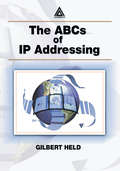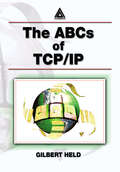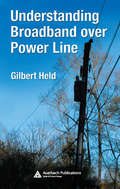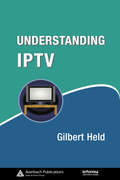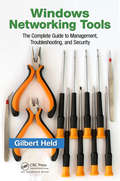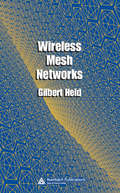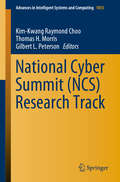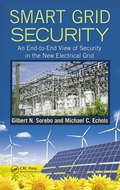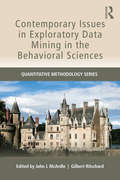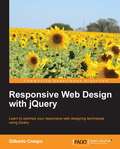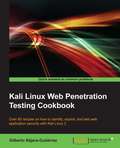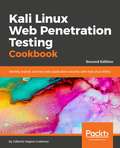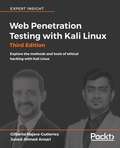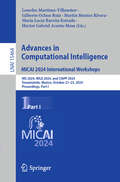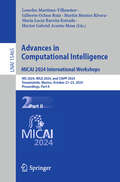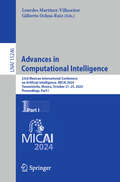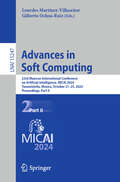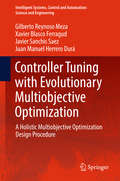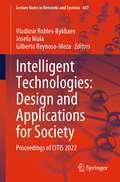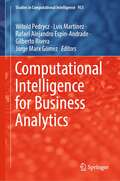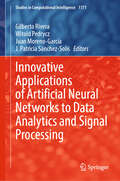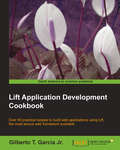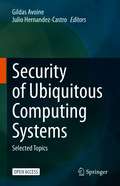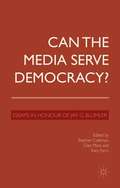- Table View
- List View
The ABCs of IP Addressing
by Gilbert HeldOur world is rapidly becoming an Internet-based world, with tens of millions of homes, millions of businesses, and within a short period of time, possibly hundreds of millions of mobile professionals accessing the literal mother of all networks. One of the key problems affecting many Internet users, ranging from individual professionals to networki
The ABCs of TCP/IP
by Gilbert HeldAdvances in networking and communications hardware based upon the TCP/IP protocol suite are opening up a new range of technologies with the potential to contribute considerably to our daily lives. The ABCs of TCP/IP is a comprehensive reference on the TCP/IP protocol suite for professionals that provides an overview of the suite and details its key components. It addresses virtual private networks, IP telephony and voice gateways, and IPSec and examines the manner by which various protocols and applications operate. Coverage also includes security techniques, routing, network design constraints, testing methods, troubleshooting, management issues, and emerging applications.
Understanding Broadband over Power Line
by Gilbert HeldUnderstanding Broadband over Power Line explores all aspects of the emerging technology that enables electric utilities to provide support for high-speed data communications via their power infrastructure. This book examines the two methods used to connect consumers and businesses to the Internet through the utility infrastructure: the existing ele
Understanding IPTV (Informa Telecoms & Media)
by Gilbert HeldDriven by a combination of technological improvements and commercial pressure, interest in IPTV services has increasingly grown. IPTV refers to the use of the Internet protocol required for delivery of television content. IPTV represents an emerging technology that could change the manner in which homes receive entertainment, personal computers ope
Windows Networking Tools: The Complete Guide to Management, Troubleshooting, and Security
by Gilbert HeldThis book discusses how built-in and third-party networking tools can be used to diagnose network problems and performance issues as well as enhance the security of computer systems. The author covers a variety of networking tools and demonstrates how they can be used to determine ahead of time whether or not existing Internet connectivity can support such activities as voice and video over IP. Coverage of other tools shows readers how to prevent keyboard hacking and negate the operation of unwanted advertisement trackers through checking for and eliminating different types of attack software.
Wireless Mesh Networks
by Gilbert HeldWireless mesh networking is a new technology that has the potential to revolutionize how we access the Internet and communicate with co-workers and friends. Wireless Mesh Networks examines the concept and explores its advantages over existing technologies. This book explores existing and future applications.
National Cyber Summit (Advances in Intelligent Systems and Computing #1055)
by Kim-Kwang Raymond Choo Thomas H. Morris Gilbert L. PetersonThese proceedings gather papers presented at the Cyber Security Education Stream and Cyber Security Technology Stream of The National Cyber Summit’s Research Track, and report on the latest advances in areas ranging from software security to cyber attack detection and modeling; the use of machine learning in cyber security; legislation and policy; surveying small businesses; cyber competition, and so on. Understanding the latest capabilities in cyber security is the best way to prepare users and organizations for potential negative events. Consequently, this book will be of interest to cyber security researchers, educators and practitioners, as well as students who want to learn about cyber security.
Smart Grid Security: An End-to-End View of Security in the New Electrical Grid
by Gilbert N. Sorebo Michael C. EcholsThe Smart Grid has the potential to revolutionize electricity delivery systems, and the security of its infrastructure is a vital concern not only for cyber-security practitioners, engineers, policy makers, and utility executives, but also for the media and consumers. Smart Grid Security: An End-to-End View of Security in the New Electrical Grid ex
Contemporary Issues in Exploratory Data Mining in the Behavioral Sciences: Contemporary Issues In Exploratory Data Mining In The Behavioral Sciences (Quantitative Methodology Series)
by Gilbert Ritschard John J. McArdleThis book reviews the latest techniques in exploratory data mining (EDM) for the analysis of data in the social and behavioral sciences to help researchers assess the predictive value of different combinations of variables in large data sets. Methodological findings and conceptual models that explain reliable EDM techniques for predicting and understanding various risk mechanisms are integrated throughout. Numerous examples illustrate the use of these techniques in practice. Contributors provide insight through hands-on experiences with their own use of EDM techniques in various settings. Readers are also introduced to the most popular EDM software programs. A related website at http://mephisto.unige.ch/pub/edm-book-supplement/offers color versions of the book’s figures, a supplemental paper to chapter 3, and R commands for some chapters. The results of EDM analyses can be perilous – they are often taken as predictions with little regard for cross-validating the results. This carelessness can be catastrophic in terms of money lost or patients misdiagnosed. This book addresses these concerns and advocates for the development of checks and balances for EDM analyses. Both the promises and the perils of EDM are addressed. Editors McArdle and Ritschard taught the "Exploratory Data Mining" Advanced Training Institute of the American Psychological Association (APA). All contributors are top researchers from the US and Europe. Organized into two parts--methodology and applications, the techniques covered include decision, regression, and SEM tree models, growth mixture modeling, and time based categorical sequential analysis. Some of the applications of EDM (and the corresponding data) explored include: selection to college based on risky prior academic profiles the decline of cognitive abilities in older persons global perceptions of stress in adulthood predicting mortality from demographics and cognitive abilities risk factors during pregnancy and the impact on neonatal development Intended as a reference for researchers, methodologists, and advanced students in the social and behavioral sciences including psychology, sociology, business, econometrics, and medicine, interested in learning to apply the latest exploratory data mining techniques. Prerequisites include a basic class in statistics.
Responsive Web Design with jQuery
by Gilberto Crespo"Responsive Web Design with jQuery" follows a standard tutorial-based approach, covering various aspects of responsive web design by building a comprehensive website."Responsive Web Design with jQuery" is aimed at web designers who are interested in building device-agnostic websites. You should have a grasp of standard HTML, CSS, and JavaScript development, and have a familiarity with graphic design. Some exposure to jQuery and HTML5 will be beneficial but isn't essential.
Kali Linux Web Penetration Testing Cookbook
by Gilberto Najera-GutierrezThis book is for IT professionals, web developers, security enthusiasts, and security professionals who want an accessible reference on how to find, exploit, and prevent security vulnerabilities in web applications. You should know the basics of operating a Linux environment and have some exposure to security technologies and tools.
Kali Linux Web Penetration Testing Cookbook: Identify, exploit, and prevent web application vulnerabilities with Kali Linux 2018.x, 2nd Edition
by Gilberto Najera-GutierrezDiscover the most common web vulnerabilities and prevent them from becoming a threat to your site's securityKey FeaturesFamiliarize yourself with the most common web vulnerabilitiesConduct a preliminary assessment of attack surfaces and run exploits in your labExplore new tools in the Kali Linux ecosystem for web penetration testingBook DescriptionWeb applications are a huge point of attack for malicious hackers and a critical area for security professionals and penetration testers to lock down and secure. Kali Linux is a Linux-based penetration testing platform that provides a broad array of testing tools, many of which can be used to execute web penetration testing. Kali Linux Web Penetration Testing Cookbook gives you the skills you need to cover every stage of a penetration test – from gathering information about the system and application, to identifying vulnerabilities through manual testing. You will also cover the use of vulnerability scanners and look at basic and advanced exploitation techniques that may lead to a full system compromise. You will start by setting up a testing laboratory, exploring the latest features of tools included in Kali Linux and performing a wide range of tasks with OWASP ZAP, Burp Suite and other web proxies and security testing tools. As you make your way through the book, you will learn how to use automated scanners to find security flaws in web applications and understand how to bypass basic security controls. In the concluding chapters, you will look at what you have learned in the context of the Open Web Application Security Project (OWASP) and the top 10 web application vulnerabilities you are most likely to encounter, equipping you with the ability to combat them effectively. By the end of this book, you will have acquired the skills you need to identify, exploit, and prevent web application vulnerabilities.What you will learnSet up a secure penetration testing laboratoryUse proxies, crawlers, and spiders to investigate an entire websiteIdentify cross-site scripting and client-side vulnerabilitiesExploit vulnerabilities that allow the insertion of code into web applicationsExploit vulnerabilities that require complex setupsImprove testing efficiency using automated vulnerability scannersLearn how to circumvent security controls put in place to prevent attacksWho this book is forKali Linux Web Penetration Testing Cookbook is for IT professionals, web developers, security enthusiasts, and security professionals who want an accessible reference on how to find, exploit, and prevent security vulnerabilities in web applications. The basics of operating a Linux environment and prior exposure to security technologies and tools are necessary.
Web Penetration Testing with Kali Linux (Third Edition): Explore the methods and tools of ethical hacking with Kali Linux
by Juned Ahmed Ansari Gilberto Nájera-GutiérrezBuild your defense against web attacks with Kali Linux, including command injection flaws, crypto implementation layers, and web application security holes Key Features - Know how to set up your lab with Kali Linux - Discover the core concepts of web penetration testing - Get the tools and techniques you need with Kali Linux Book Description Web Penetration Testing with Kali Linux - Third Edition shows you how to set up a lab, helps you understand the nature and mechanics of attacking websites, and explains classical attacks in great depth. This edition is heavily updated for the latest Kali Linux changes and the most recent attacks. Kali Linux shines when it comes to client-side attacks and fuzzing in particular. From the start of the book, you'll be given a thorough grounding in the concepts of hacking and penetration testing, and you'll see the tools used in Kali Linux that relate to web application hacking. You'll gain a deep understanding of classicalSQL, command-injection flaws, and the many ways to exploit these flaws. Web penetration testing also needs a general overview of client-side attacks, which is rounded out by a long discussion of scripting and input validation flaws. There is also an important chapter on cryptographic implementation flaws, where we discuss the most recent problems with cryptographic layers in the networking stack. The importance of these attacks cannot be overstated, and defending against them is relevant to most internet users and, of course, penetration testers. At the end of the book, you'll use an automated technique called fuzzing to identify flaws in a web application. Finally, you'll gain an understanding of web application vulnerabilities and the ways they can be exploited using the tools in Kali Linux. What you will learn Learn how to set up your lab with Kali Linux Understand the core concepts of web penetration testing Get to know the tools and techniques you need to use with Kali Linux Identify the difference between hacking a web application and network hacking Expose vulnerabilities present in web servers and their applications using server-side attacks Understand the different techniques used to identify the flavor of web applications See standard attacks such as exploiting cross-site request forgery and cross-site scripting flaws Get an overview of the art of client-side attacks Explore automated attacks such as fuzzing web applicationsWho this book is for Since this book sets out to cover a large number of tools and security fields, it can work as an introduction to practical security skills for beginners in security. In addition, web programmers and also system administrators would benefit from this rigorous introduction to web penetration testing. Basic system administration skills are necessary, and the ability to read code is a must.
Web Penetration Testing with Kali Linux - Third Edition: Explore The Methods And Tools Of Ethical Hacking With Kali Linux, 3rd Edition
by Gilberto Nájera-GutiérrezWeb Penetration Testing with Kali Linux - Third Edition shows you how to set up a lab, helps you understand the nature and mechanics of attacking websites, and explains classical attacks in great depth. This edition is heavily updated for the latest Kali Linux changes and the most recent attacks. Kali Linux shines when it comes to client-side attacks and fuzzing in particular. From the start of the book, you'll be given a thorough grounding in the concepts of hacking and penetration testing, and you'll see the tools used in Kali Linux that relate to web application hacking. You'll gain a deep understanding of classicalSQL, command-injection flaws, and the many ways to exploit these flaws. Web penetration testing also needs a general overview of client-side attacks, which is rounded out by a long discussion of scripting and input validation flaws. There is also an important chapter on cryptographic implementation flaws, where we discuss the most recent problems with cryptographic layers in the networking stack. The importance of these attacks cannot be overstated, and defending against them is relevant to most internet users and, of course, penetration testers. At the end of the book, you'll use an automated technique called fuzzing to identify flaws in a web application. Finally, you'll gain an understanding of web application vulnerabilities and the ways they can be exploited using the tools in Kali Linux.
Advances in Computational Intelligence. MICAI 2024 International Workshops: HIS 2024, WILE 2024, and CIAPP 2024, Tonantzintla, Mexico, October 21–25, 2024, Proceedings, Part I (Lecture Notes in Computer Science #15464)
by Lourdes Martínez-Villaseñor Héctor Gabriel Acosta-Mesa Gilberto Ochoa-Ruiz Martin Montes Rivera María Lucía Barrón-EstradaThis book constitutes the revised selected papers of several workshops which were held in conjunction with the MICAI 2024 International Workshops on Advances in Computational Intelligence, MICAI 2024, held in Tonantzintla, Mexico, during October 21–25, 2024. The 38 revised full papers presented in this book were carefully reviewed and selected from 58 submissions. The papers presented in this volume stem from the following workshops: – 17th Workshop of Hybrid Intelligent Systems (HIS 2024) – 17th Workshop on Intelligent Learning Environments (WILE 2024) – 6th Workshop on New Trends in Computational Intelligence and Applications (CIAPP 2024).
Advances in Computational Intelligence. MICAI 2024 International Workshops: HIS 2024, WILE 2024, and CIAPP 2024, Tonantzintla, Mexico, October 21–25, 2024, Proceedings, Part II (Lecture Notes in Computer Science #15465)
by Lourdes Martínez-Villaseñor Héctor Gabriel Acosta-Mesa Gilberto Ochoa-Ruiz Martin Montes Rivera María Lucía Barrón-EstradaThis book constitutes the revised selected papers of several workshops which were held in conjunction with the MICAI 2024 International Workshops on Advances in Computational Intelligence, MICAI 2024, held in Tonantzintla, Mexico, during October 21–25, 2024. The 38 revised full papers presented in this book were carefully reviewed and selected from 58 submissions. The papers presented in this volume stem from the following workshops: – 17th Workshop of Hybrid Intelligent Systems (HIS 2024) – 17th Workshop on Intelligent Learning Environments (WILE 2024) – 6th Workshop on New Trends in Computational Intelligence and Applications (CIAPP 2024).
Advances in Computational Intelligence: 23rd Mexican International Conference on Artificial Intelligence, MICAI 2024, Tonantzintla, Mexico, October 21–25, 2024, Proceedings, Part I (Lecture Notes in Computer Science #15246)
by Lourdes Martínez-Villaseñor Gilberto Ochoa-RuizThe two-volume set, LNAI 15246 and 15247, constitutes the proceedings of the 23rd Mexican International Conference on Artificial Intelligence, MICAI 2024, held in Tonantzintla, Mexico in October 21–25, 2024. The 37 full papers presented in these proceedings were carefully reviewed and selected from 141 submissions. The papers presented in these two volumes are organized in the following topical sections: Part I - Machine Learning; Computer Vision. Part II - Intelligent Systems; Bioinformatics and Medical Applications; Natural Language Processing.
Advances in Soft Computing: 23rd Mexican International Conference on Artificial Intelligence, MICAI 2024, Tonantzintla, Mexico, October 21–25, 2024, Proceedings, Part II (Lecture Notes in Computer Science #15247)
by Lourdes Martínez-Villaseñor Gilberto Ochoa-RuizThe two-volume set, LNAI 15246 and 15247, constitutes the proceedings of the 23rd Mexican International Conference on Artificial Intelligence, MICAI 2024, held in Tonantzintla, Mexico in October 21–25, 2024. The 37 full papers presented in these proceedings were carefully reviewed and selected from 141 submissions. The papers presented in these two volumes are organized in the following topical sections: Part I - Machine Learning; Computer Vision. Part II - Intelligent Systems; Bioinformatics and Medical Applications; Natural Language Processing.
Controller Tuning with Evolutionary Multiobjective Optimization: A Holistic Multiobjective Optimization Design Procedure (Intelligent Systems, Control and Automation: Science and Engineering #85)
by Gilberto Reynoso Meza Xavier Blasco Ferragud Javier Sanchis Saez Juan Manuel Herrero DuráThis book is devoted to Multiobjective Optimization Design (MOOD) procedures for controller tuning applications, by means of Evolutionary Multiobjective Optimization (EMO). It presents developments in tools, procedures and guidelines to facilitate this process, covering the three fundamental steps in the procedure: problem definition, optimization and decision-making. The book is divided into four parts. The first part, Fundamentals, focuses on the necessary theoretical background and provides specific tools for practitioners. The second part, Basics, examines a range of basic examples regarding the MOOD procedure for controller tuning, while the third part, Benchmarking, demonstrates how the MOOD procedure can be employed in several control engineering problems. The fourth part, Applications, is dedicated to implementing the MOOD procedure for controller tuning in real processes.
Intelligent Technologies: Proceedings of CITIS 2022 (Lecture Notes in Networks and Systems #607)
by Josefa Mula Vladimir Robles-Bykbaev Gilberto Reynoso-MezaThis book is oriented towards applications and perspectives on future developments connected to intelligent technologies. Specifying topics connected to industry, mobility, telecommunications, biomechanics, among others. The innovative character of the text allows relating technical experiences and advances that seek to improve the implication of new technologies at local, national and regional levels, demonstrating the advances towards the different fields of knowledge in the area of engineering. The potential readers of this work would be master and doctorate students, professors–researchers in the field of new technologies and companies connected to the development of engineering. The texts serve to illustrate new procedures, new cases and new techniques for the optimization of systems that optimize social progress.
Computational Intelligence for Business Analytics (Studies in Computational Intelligence #953)
by Witold Pedrycz Jorge Marx Gómez Luis Martínez Rafael Alejandro Espin-Andrade Gilberto RiveraCorporate success has been changed by the importance of new developments in Business Analytics (BA) and furthermore by the support of computational intelligence- based techniques. This book opens a new avenues in these subjects, identifies key developments and opportunities. The book will be of interest for students, researchers and professionals to identify innovative ways delivered by Business Analytics based on computational intelligence solutions. They help elicit information, handle knowledge and support decision-making for more informed and reliable decisions even under high uncertainty environments.Computational Intelligence for Business Analytics has collected the latest technological innovations in the field of BA to improve business models related to Group Decision-Making, Forecasting, Risk Management, Knowledge Discovery, Data Breach Detection, Social Well-Being, among other key topics related to this field.
Innovative Applications of Artificial Neural Networks to Data Analytics and Signal Processing (Studies in Computational Intelligence #1171)
by Witold Pedrycz Gilberto Rivera Juan Moreno-García J. Patricia Sánchez-SolísThis book deals with the application of ANNs in real-world problems requiring data analysis and signal processing. Artificial neural networks (ANNs) have emerged in society thanks to the large number of applications that have been used in an awe-inspiring way. These networks offer effective solutions to practical, real-world problems. The wide variety of application fields of the studies in the book is remarkable; these are related to sensorization, agriculture, healthcare, air pollution, video games, and cybersecurity, among others. To organize this variety, the chapters have been grouped into three sections related to: (1) Forecasting and Prediction, (2) Knowledge Discovery and Knowledge Management, and (3) Signal Processing. This book aims to reach readers interested in ANNs and their applications in different fields, so it is interesting not only for computer science but also for other related disciplines.
Lift Application Development Cookbook
by Gilberto T. Garcia Jr.Lift Application Development Cookbook contains practical recipes on everything you will need to create secure web applications using this amazing framework.The book first teaches you basic topics such as starting a new application and gradually moves on to teach you advanced topics to achieve a certain task. Then, it explains every step in detail so that you can build your knowledge about how things work.This book is for developers who have at least some basic knowledge about Scala and who are looking for a functional, secure, and modern web framework. Prior experience with HTML and JavaScript is assumed.
Security of Ubiquitous Computing Systems: Selected Topics
by Gildas Avoine Julio Hernandez-CastroThe chapters in this open access book arise out of the EU Cost Action project Cryptacus, the objective of which was to improve and adapt existent cryptanalysis methodologies and tools to the ubiquitous computing framework. The cryptanalysis implemented lies along four axes: cryptographic models, cryptanalysis of building blocks, hardware and software security engineering, and security assessment of real-world systems.The authors are top-class researchers in security and cryptography, and the contributions are of value to researchers and practitioners in these domains.This book is open access under a CC BY license.
Can the Media Serve Democracy?
by Stephen Coleman Giles Moss Katy ParryThis landmark collection brings leading scholars in the field of political communication to debate one of the most important questions of our age: Can the media serve democracy? For the media to be democratic, they must enter into a positive relationship with their readers, viewers and listeners as citizens rather than consumers who buy things, audiences who gaze upon spectacles or isolated egos, obsessed with themselves. The media's first task is to remind people that they are inhabitants of a world in which they can make a difference. By enabling citizens to encounter and make sense of events, relationships and cultures of which they have no direct experience, the media constitute a public arena in which members of the public come together as more than passing strangers.
